Smart Tools
Smart tools in Clip Studio Paint can smooth images that are pixelated from resizing, instantly colorize line drawings, and remove screentone dots from images.
Smart Smoothing
Smart Smoothing is a feature that smooths images and reduces pixel noise caused by enlarging an image when changing the resolution or transforming it. You can only use Smart Smoothing on raster and image material layers (excluding image materials using vectors).
Use this feature by selecting a layer and then tapping the Edit menu > Smart Smoothing. Then, adjust the settings in the Smart Smoothing dialog and tap OK.
For images with jaggies caused by low resolution, applying Change Image Resolution from the Edit menu to scale the image up before Smart Smoothing will give a better result.
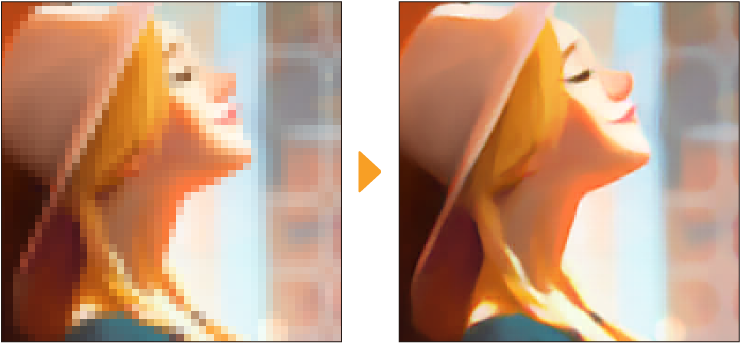
You can adjust the following settings:
Intensity
Specifies the strength for Smart Smoothing. The appropriate Intensity depends on the scale ratio of the image.Weak is aimed for images that have been doubled in size, Middle for images that have been tripled in size, and Strong for images that have been quadrupled in size.
Remove noise
Removes noise from the image.
Processing unit
Selects the hardware used to process the Smart Smoothing. Depending on your device, you might not be able to select this.
Preview
Shows a preview of the results on the canvas. The larger the canvas size, the longer it may take for the preview to load. Hold down Esc to stop the preview.
Colorize (Technology preview)
This function uses machine learning technology to automatically colorize line art merged into a single layer.
Important | When you use this feature, the image data is uploaded to a server, where the server interprets the data and colors the image. A network connection is necessary to use this function. For information on images uploaded to the server and generated data, see "About AI features". |
Colorize all
First, select the layer with your line art and set it as the reference layer.
Then select Edit > Colorize (Technology preview) > Colorize all. This will create a new raster layer on top of the selected layer with the colorized result.
For details on reference layers, see "Reference layers".

Use hint image and colorize
In addition to the line art, you can also create a hint layer to specify the colors when colorizing the image. You can use one lineart layer and one hint layer with Use hint image and colorize. Multiple layers cannot be referenced.
Select the layer your line art is on and set it as the reference layer. Create a new raster layer and paint the colors that will serve as a hint for the colorization. Then select Edit menu > Colorize (Technology preview) > Use hint image and colorize. This will create a new raster layer on top of the selected layer with the Colorized result. The hint layer will be hidden.
For details on reference layers, see "Reference layers".

Use more advanced settings
In addition to line art, you can create a layer with colors as a hint, and then use the Auto Colorize dialog to adjust the colorization method.
First, create your line art and color hint layers.
Then select Edit menu > Colorize (Technology preview) > Use more advanced settings. This will open the Colorize dialog. Make color adjustments in the Colorize dialog and tap OK.
This will create a new raster layer above the line art layer with the colorized result. The hint layer will be hidden.
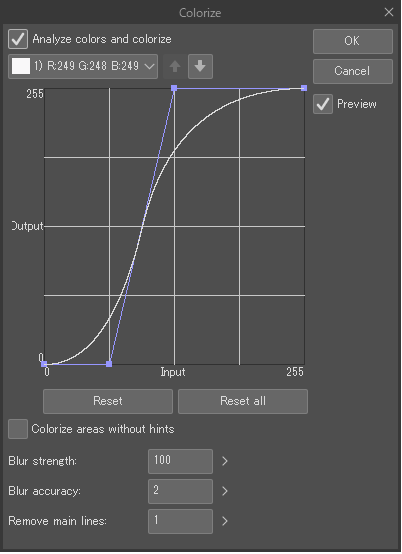
Analyze colors and colorize
When active, automatic coloring is performed for each color on the hint layer. The color output can be adjusted with the Tone Curve graph.
Select color
Selects the color to adjust with the Tone Curve graph. The order of the dropdown menu reflects the order of processing in the case of overlapping colors. The current hint color is shown on the dropdown. If there are more than 10 hint colors, the 10 colors with the largest areas are extracted. We recommend using no more than 10 solid hint colors.
Up
Moves the selected color one step up.
Down
Moves the selected color one step down.
Tone Curve
Adjusts the output of the selected part. Drag the control points to adjust.
Reset
Resets the tone curve setting for the selected color.
Reset all
Resets the tone curve settings for all colors.
Colorize areas without hints
When turned on, the results will be combined with the results that would be made with Colorize all.
Blurring intensity
Sets the intensity of blurring the coloring results for lines and line boundaries. The larger the number, the more blurred the colors are.
Blurring accuracy
Specifies the number of times to calculate the blur. The larger the number, the smoother the blur effect will be.
Remove main lines
Makes main lines less visible by expanding the bright areas of an image. The larger the value, the wider the bright areas become.
Preview
Shows a preview of the results on the canvas.
Remove tones (Technology preview)
Selected screentones on a raster layer can be removed or converted to grayscale. This is useful when loading manuscripts created with traditional media or files that have been flattened. If you create a selection area, the effect will only be applied to that area.
When used on a raster layer with the expression color set to Color, the image will be converted to grayscale.
Important | This function is a technology preview. You can try it out before its official release. This feature cannot be used on images with height x width dimensions exceeding 53,000,000 pixels. When you use this feature, the image data is uploaded to the server, where the server interprets the data and converts the tones. A network connection is necessary to execute this function. For information on images uploaded to the server and generated data, see "About AI features". |
Memo | You cannot use Remove tones (Technology preview) in Clip Studio Paint DEBUT or PRO versions |
Delete tones from selected layer
You can remove screentones from raster layers. Select the layer and tap Edit menu > Remove tones (Technology Preview) > Delete tones from selected layer.
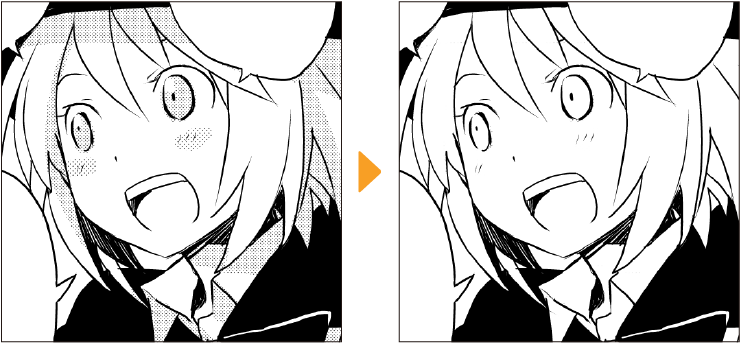
Change tones to grayscale
The screentones on a raster layer can be changed to grayscale. Select the layer and tap Edit menu > Remove tones (Technology Preview) > Change tones to grayscale.

Shading Assist
Shading Assist automatically creates shadows based on your color and lineart layers. You can use the Shading Assist dialog and on-screen manipulator to change the appearance of the shadows and the position of the light source.
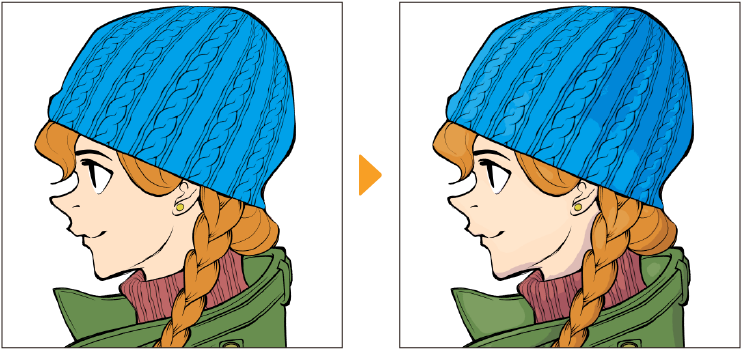
To use Shading Assist, first you will need a canvas with an illustration divided into a lineart layer and a color layer for the base colors of your work.
·Line art layers should be set as "Reference layers".
·Color layers should be flat colors with little color variation, such as "Fill layers", in order to apply the shading.
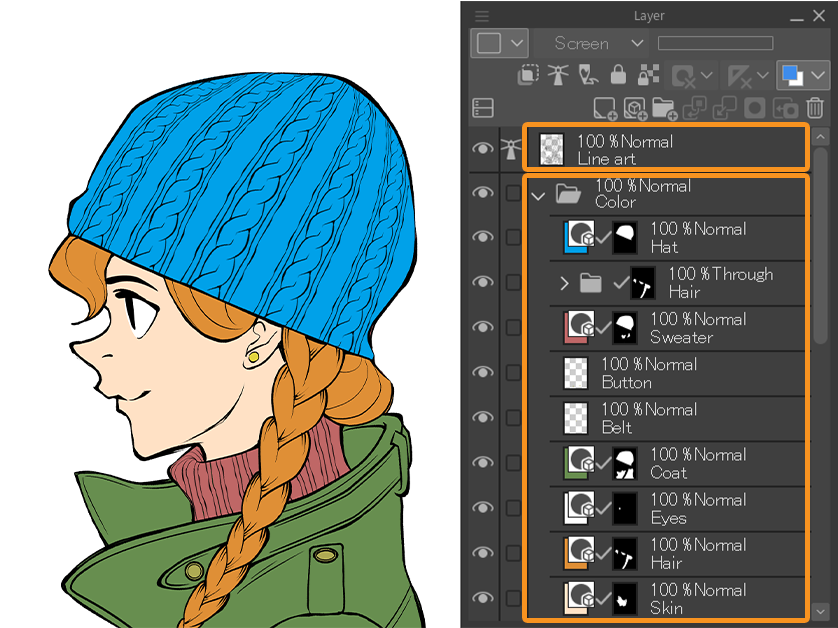
Memo | The entire selection of color layers and lineart layers can only include up to 250 colors to use Shading Assist. |
In the Layer palette, select all the color and lineart layers that you want to reference. Then, go to the Edit menu > Shading Assist to open the Shading Assist dialog and show the light source manipulator.
If referencing line art, check that Refer to lines on reference layer is turned on in the dialog.
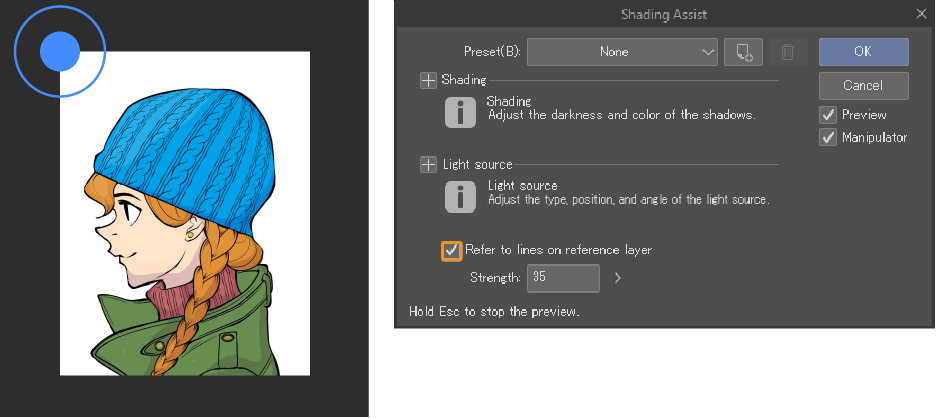
Next, adjust the shading effect by choosing a preset or adjusting the Shading and Light source settings. For details, see "Shading Assist settings".

Adjust the position of the light source by dragging it on the canvas. You can drag along the outer ring to change the strength of the light. For details, see "Light source manipulator".
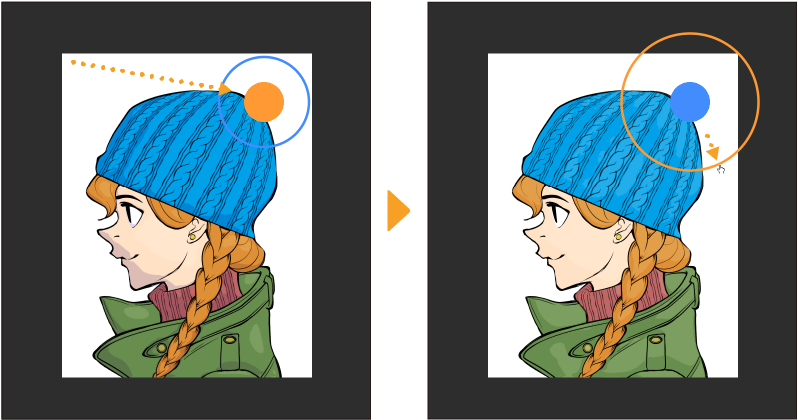
When you’re satisfied, tap OK to apply the shading effect. A new layer with the shading will be created above the color layers.
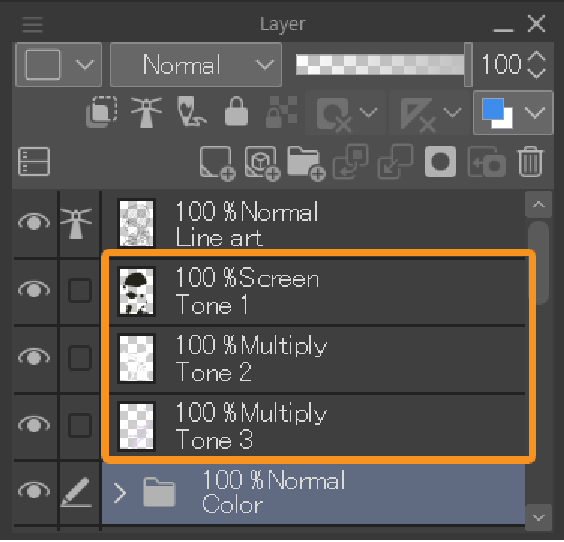
Shading Assist settings
You can adjust the shading effect in detail, apply presets, and save new presets in the Shading Assist dialog.
You can use existing presets, or tap the plus sign next to Shading and Light source to see all settings available.
Memo | In Clip Studio Paint DEBUT, you can only choose from existing presets, change the light source type, and change reference layer settings. |
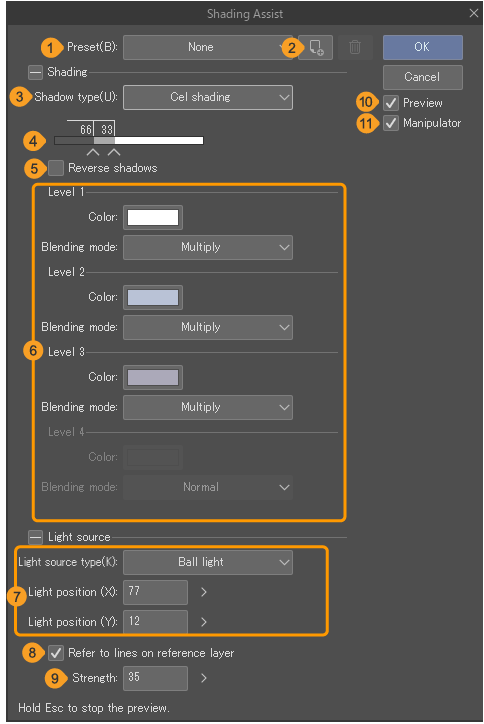
(1)Preset
The drop-down menu features different presets you can use for different situations. Saved presets will also appear in this list.

(2)Save to preset
Save your custom shading settings to the Preset list. A dialog will appear prompting you to name the preset.
(3)Shadow type
There are two shading types. Depending on the Shadow type chosen, other settings in the dialog will change.
Smooth shading: A smooth blended transition between shaded and non-shaded areas, with separate layers for shadow and highlights.
Cel shading: A distinct border between shaded and non-shaded areas. It can generate up to four shadow levels, each created as a separate layer.
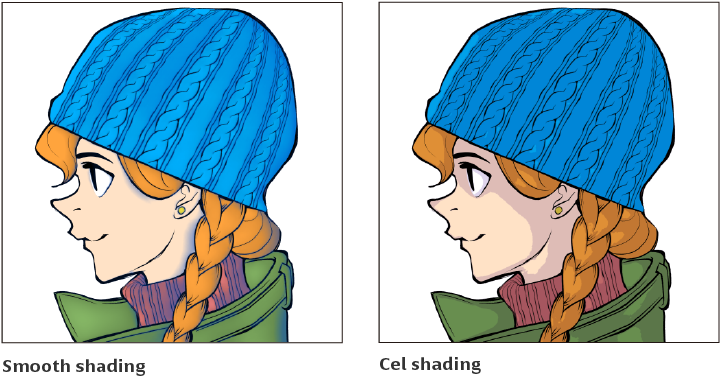
(4)Shading scale
When the shadow type is set to Cel shading, you can set the proportion of each shadow level by adjusting the sliders. Tap on the bar to add an additional level, or drag the arrows vertically off the bar to remove them.
(5)Reverse shadows
When on, shadows and highlights are inverted.
(6)Shadow/Highlight color settings
The shadow/highlight color settings depend on the Shadow type selected.
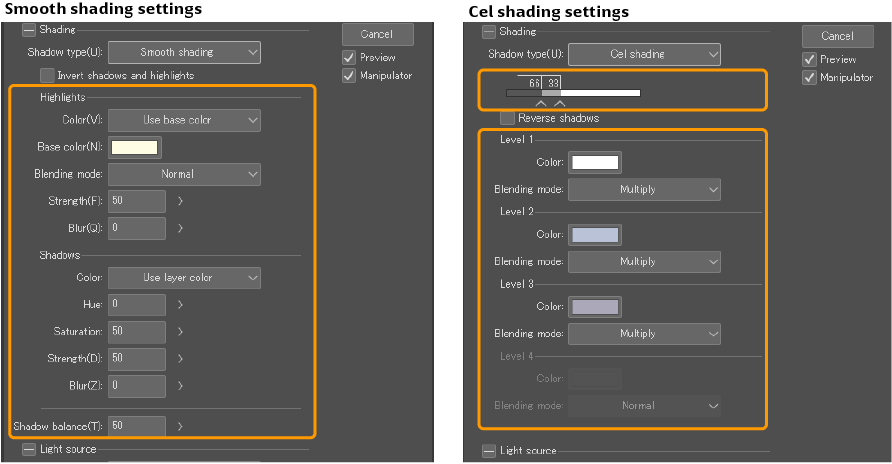
Smooth shading
Set the color, blending mode, strength, and blur of the shadows and highlights.
·Color: Set the shadow/highlight color to Use layer color or Use base color. If set to Use base color, a color selection box will appear for you to set a custom color.
·Blending mode: When the color is set to Use base color, specify the blending mode to apply to the color layers.
·Hue/Saturation: When the color is set to Use layer color, set the hue and saturation.
·Strength: Set the strength of the applied color.
·Blur: Set the radius of the blur.
·Shadow balance: Adjust the proportion of shadows.
Cel shading
·Adjust the shadow and highlight levels using the shading bar.
·Set the color and blending mode of each level using the color bar and drop-down menu for blending modes.
·Tap the shading bar to add an additional level, or drag arrows off the bar to remove them.
(7)Light source type
Use the drop-down menu to select the light source type. The light source manipulator on the canvas will also change accordingly.
Ball light: This places a light source that can be moved to anywhere on the canvas.Ball light tends to produce more easily recognizable shadows than Directional light. When the light source type is Ball light, you can adjust the Light position (X/Y) setting to move the light source relative to the canvas’s width and height.
Directional light: This applies light to the entire canvas at the same angle and intensity to generate shading. When the light source type is Directional light, you can adjust the Light angle setting, which determines the angle from which the light shines.
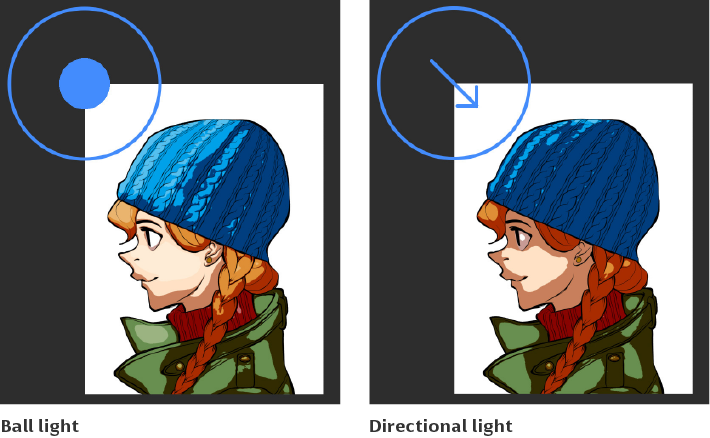
(8)Refer to lines on reference layer
When turned on, Shading Assist refers to lines on the reference layer to generate shading. When off, shading is generated using only the information on the color layers.
(9)Strength
This is enabled when Refer to lines on reference layer is turned on. It sets the strength at which the line art influences the shading.
(10)Preview
Check this box to show or hide a preview on the canvas.
(11)Manipulator
Check this box to show or hide the light source manipulator on the canvas.
Light source manipulator
You can use the light source manipulator to adjust the shading effect. The image below shows Ball light on the left and Directional light on the right.
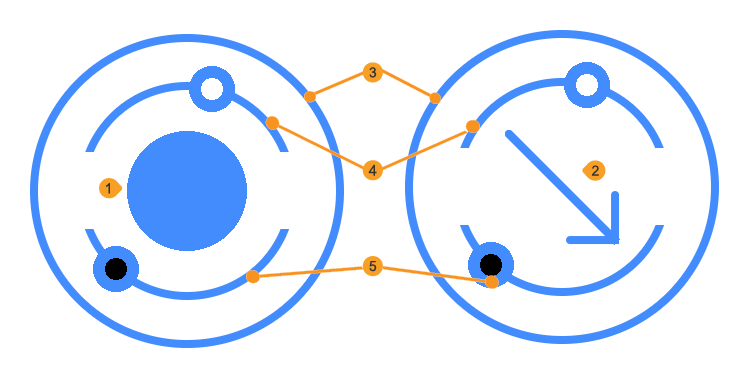
(1)Light position
When set to Ball light, drag the inner circle to move the light source anywhere on the canvas.
(2)Light angle
When set to Directional light, rotate the arrow to adjust the angle of the light. You can also drag the light source manipulator to move it; however, this does not affect the shading.
(3)Light intensity
Adjust the intensity of the light by dragging the inner circle inwards or outwards to change its size. The larger it is, the stronger the light effect. The parameters that are adjusted depend on the type of shading.
Smooth shading: The larger the circle, the smaller the amount of shadow areas.
Cel shading: The size of the ring corresponds to the shading bar. The larger the circle, the larger the proportion of highlights.
(4)Highlight strength
This inner ring appears when the shading type is Smooth shading. Drag to the right to increase the strength of the highlights.
(5)Shadow strength
This inner ring appears when the shading type is Smooth shading. Drag to the right to increase the strength of the shadows.